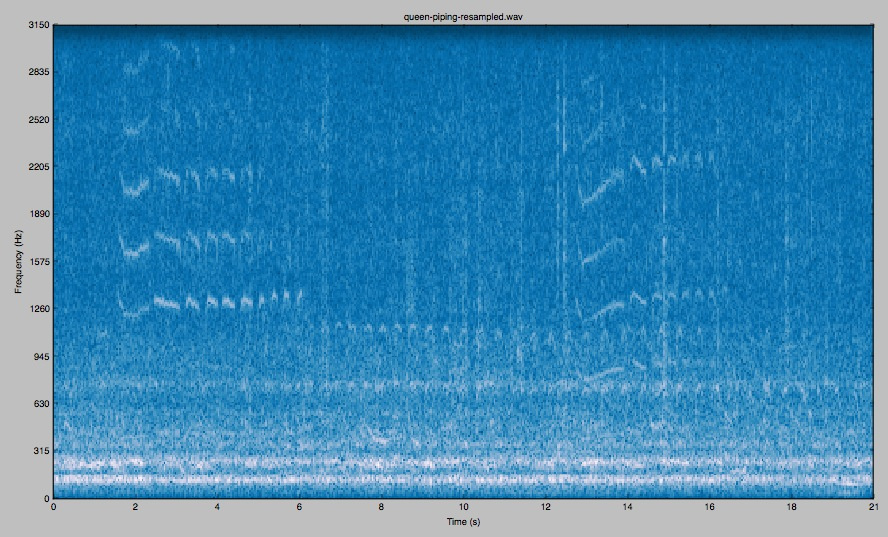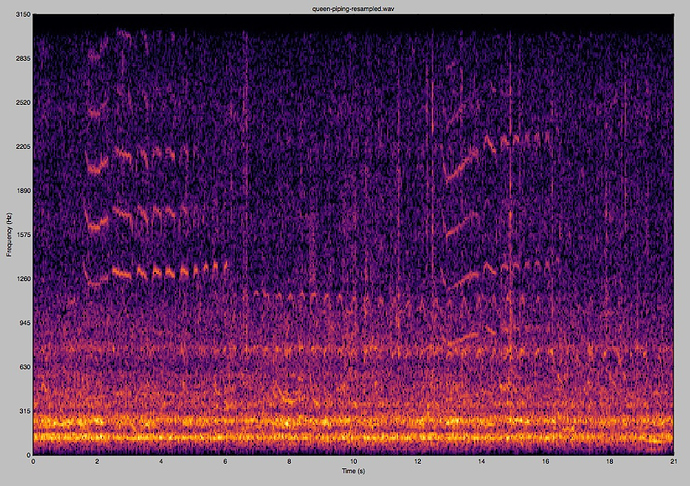Hey, hey YET!! When is your birthday? We will flood you with beekeeping equipment! ;-)
There is an interesting thread about “Tüten und Quaken” (in german) Tüten und Quäken - Fragen, Hinweise, Tipps und Ratschläge, nicht nur für Einsteiger - Imkerforum seit 1996 but let me paraphrase some highlights:
Especially the research outcome from Seeley published in “Honeybee Democracy” is relevant: On page 41 is a graph with “toot” an “quack” on a timeline. Unfortunately without exact numbers for the frequencies.
The “toot” from the emerged queen and the phase is in the graph 2-6 seconds long with short breaks (< 1 s) in between. “Quack” is about 1 sec with also 1 sec break. In the graph about 20x repeated, this is from the not yet emerged queen. .
Some frequency numbers and sound examples I got http://www.lcbaor.org/piping.htm But unfortunately with a broad Hz range:
A “toot” is produced by a queen that has emerged from her cell and is moving freely within the nest. […]
Toot: Typical duration: 5 sec single long syllable followed by several short syllables. fundamental frequencies from 350 - 550 Hz
A “quack” is produced by a queen that has pupated into an adult, but remains imprisoned in her cell. […] Quack: Typical duration: more than 10 sec long, series of short syllables. fundamental frequencies from 200 - 350 Hz
Woods / Boys https://beedata.com.mirror.hiveeyes.org/data2/listen/listenbees.htm reports three different piping formats of the queens:
- The emerged - after the swarm is gone - virgin queen makes a “‘full round hoot’ or a ‘whoo‑whoo’” with "340 Hz at first, falling slightly as the wings harden.
- The imprisoned queen can make from 5 days after covering with 450 Hz “a feeble bleat which also falls as she approaches emergence”
He describes also the rarely situation when the (old) queen can not swarm because of bad weather conditions:
Clearly, piping usually occurs after a swarm has departed; the old queen does not challenge an immature one in her cell. However, there may be occasions when bad weather delays the emergence of the swarm in which case young queens may find themselves near the old lady, whose pipe was described by Eddie as a “quark”. (a cross between a quack and a squawk?) It also varies in volume depending on the extent to which her tracheae are distorted by egg‑full ovaries.
You can find a more detailed description what is going on before and after swarming in this posting (sorry, german!) from me:
https://www.imkerforum.de/forum/thread/29251-tüten-und-quäken/?postID=315832#post315832
And a second one about worker piping from the scout Bees immediately before swarming out:
https://www.imkerforum.de/forum/thread/29251-tüten-und-quäken/?postID=315058#post315058
Worker piping could be the biological base for queen piping but this is just a theory. From the signals it could be similar the queen piping so we should have it in mind while analyzing bee colony’s pulsing sound.



